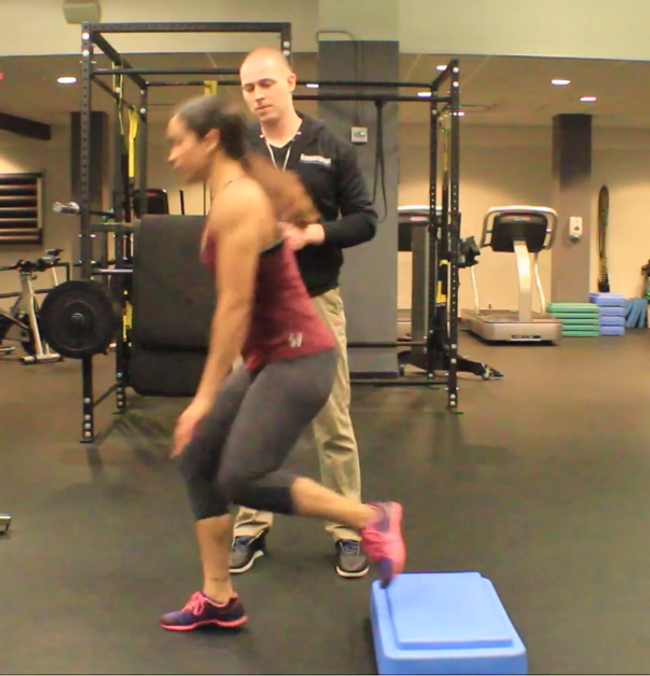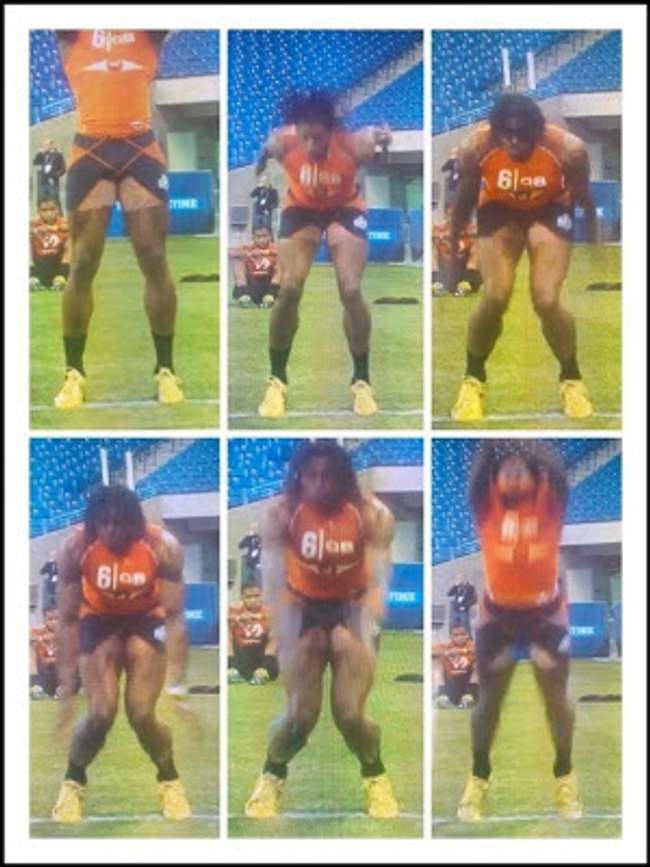Research Review: Strength Training Intervention and Its Effects on Tibiofemoral Loading During Landing
By Tristan J. Rodik, M.AT., ATC
Edited By Brent Brookbush, DPT, PT, COMT, MS, PES, CES, CSCS, ACSM H/FS
Original Citation: Czasche, M. B., Goodwin, J. E., Bull, A. M. J. and Cleather, D. J. (2018) Effects of an 8-week strength training intervention on tibiofemoral joint loading during landing: a cohort study. BMJ Open Sport & Exercise Medicine, 4(1), doi: 10.1136/bmjsem-2017-000273. Full Article
Why the Study is Relevant: Prior research has demonstrated that exercise programs designed to improve knee alignment, such as a functional knee valgus, may help reduce the incidence of anterior cruciate ligament (ACL) injuries (1-7). This 2018 study demonstrated that strengthening of the glute complex (gluteus medius and gluteus maximus ) and hamstrings resulted in a decrease in lateral load and increase in medial load at the knee during landing, which is consistent with a reduction in knee valgus. The findings of this study imply that human movement professionals may consider integrating glute complex and hamstring exercises to reduce the occurrence of ACL injuries.

Practicing Hop Down to Single Leg Touch Down in the Transverse Plane with a Soft Landing
Study Summary
| Study Design | Cohort Study |
| Level of Evidence | IIB Evidence from at least one other type of quasi-experimental study |
| Participant Characteristics | Demographics Intervention Group:
Control Group:
Inclusion Criteria:
Exclusion Criteria:
|
| Methodology | Pre-Intervention Testing:
Exercise Intervention (Intervention Group):
Post-Intervention Testing:
|
| Data Collection and Analysis |
|
| Outcome Measures | |
| Results |
|
| Our Conclusions | The findings reveal that the IG group experienced a decrease in lateral force and increase in medial force knee joint forces. This suggests that glute complex and hamstring strengthening in active women will help develop favorable knee force distribution. |
| Researchers' Conclusions | Posterior thigh strengthening increases use of the gluteal musculature during a drop landing task. Knee joint contact forces shifted from a lateral to medial emphasis. This change is indicative of reduced knee valgus and an increased hip joint loading pattern. |

Robert Griffin III during a vertical jump test his rookie year. Note his knees bow in, a.k.a. functional valgus.
Why This Study is Important:
This study adds to a growing body of research supporting the use of glute complex strengthening to improve lower-extremity biomechanics (8-14). Unique to this study, the authors used musculoskeletal modelling to estimate medial and lateral internal knee joint loads during unilateral and bilateral landing pre- and post intervention. The intervention used in this study was 8 weeks glute complex and hamstring strengthening. The findings of this study imply that intervention resulted in a decrease in lateral load and increase in medial load (more balanced force distribution). This may imply that glute complex and hamstring strengthening has the potential to reduce the risk of knee injury.
How the Findings Apply to Practice:
Human movement professionals should consider incorporating glute complex and hamstring strengthening into the program of any individual at risk of knee injury during daily activity and sport. Note: Although the Brookbush Institute (BI) recommends glute complex strengthening, it does not recommend specific strengthening exercises for the hamstrings (described below). Further, this study demonstrated that it may be necessary to incorporate and progress several exercises, over several weeks to make considerable change. Further research is needed to determine minimum and maximum volumes.
This study had many methodological strengths, including:
- The use of common strengthening exercises for the glute complex and hamstrings including lunges , Nordic hamstring curls , glute bridges , step-ups , and squats , improves applicability.
- The drop landing task included bilateral and unilateral landings, which are both seen in sport resulting in anterior cruciate ligament injuries.
- Compliance among members of the intervention group was high, with 94% attendance of strengthening sessions further strengthening statistical analysis of the data.
- This study used musculoskeletal modelling to estimate internal knee joint forces, which provided a greater understanding of medial and lateral joint loading.
Weaknesses that should be noted prior to clinical integration:
- All participants were recreationally active, right-foot dominant females, which may limit generalizability to sedentary and/or male populations.
- The small sample size, 16 participants, may have impacted the statistical significance of the results.
- Hip strength testing was assessed using a force plate, which may limit practical application of findings.
- Gluteal measures during the drop landing task were measured via ground reaction forces and not directly through electromyography analysis
How This Study Related to Brookbush Institute Content:
The Brookbush Institute (BI) uses an integrated approach to address Lower Extremity Dysfunction (LED) , Lumbo-pelvic Hip Complex Dysfunction (LPHCD) and Sacroiliac Joint Dysfunction (SIJD) . Any one or a combination of these dysfunctions may result in the altered pattern noted in this study, knee valgus during landing. Although this study provides evidence for the use of gluteus maximus , gluteus medius and hamstring strengthening to address this altered movement pattern, the BI does not support the use of specific (single joint) hamstring strengthening. As noted in the models above (LED , LPHCD , SIJD ), the hamstrings , especially the biceps femoris , are prone to over-activity and synergistic dominance for an inhibited/under-active gluteus maximus and gluteus medius . Therefore, the Nordic hamstring exercise and hamstring curls are not recommended by the BI. Integrated (multi-joint) triple extension exercises like lunges , glute bridges , step-ups , and squats , are recommended after addressing under-active muscles with isolated activation techniques.
Functional Anatomy of the Gluteus Maximus and Gluteus Medius
Gluteus Maximus Manual Muscle Testing
Glute Activation Circuit
Ultimate Glute Bridge
Static Lunge to Row
Recommended Readings:
- Activation exercises that target the gluteus medius with minimal tensor fascia latae activation.
- Anterior hip capsule mobilization and its effect on gluteus maximus activation .
- Electromyographic analysis of common gluteus medius and gluteus maximus exercises.
Bibliography:
- Sadoghi, P., von Keudell, A. and Vavken, P. (2012) Effectiveness of anterior cruciate ligament injury prevention training programs. Journal of Bone and Joint Surgery, 94, 769-776
- Myklebust, G., Engebretsen, L., Braekken, I. H., Skjolberg, A., Olsen, O. E. and Bahr, R. (2003) Prevention of anterior cruciate ligament injuries in female handball players: a prospective intervention study over three seasons. Clinical Journal of Sports Medicine, 13, 71-78
- Gagnier, J. J., Morgenstern, H. and Chess, L. (2013) Interventions designed to prevent anterior cruciate ligament injuries in adolescents and adults: a systematic review and meta-analysis. American Journal of Sports Medicine, 41, 1952-1962
- Omi, Y., Sugimoto, D., Kuriyama, T., Miyamoto, K., Yun, S., Kawashima, T. and Hirose, N. (2018) Effect of hip-focused injury prevention training for anterior cruciate ligament injury reduction in female basketball players: a 12-year prospective intervention study. American Journal of Sports Medicine, doi: 10.1177/0363546517749474
- Silvers-Granelli, H. J., Bizzini, M., Arundale, A., Mandelbaum, B. R. and Snyder-Mackler, L. (2017) Does the FIFA 11+ injury prevention program reduce the incidence of ACL injury in male soccer players? Clinical Orthopaedics and Related Research, 475(10), 2447-2455
- Chappell, J. D. and Limpisvasti, O. (2008) Effect of a neuromuscular training program on the kinetics and kinematics of jumping tasks. American Journal of Sports Medicine, 36, 1081-1086
- Michaelidis, M. and Koumantakis, G. A. Effects of knee injury primary prevention programs on anterior cruciate ligament injury rates in female athletes in different sports: a systematic review. Physical Therapy in Sport, 15, 200-210
- Baldon, R. D. M., Serrao, F. V., Silva, R. S. and Piva, S. R. (2014) Effects of functional stabilization training on pain, function, and lower extremity biomechanics in women with patellfemoral pain: a randomized clinical trial. Journal of Orthopaedic and Sports Physical Therapy, 44(4), 240-A8
- Noehren, B., Scholz, J. and Davis, I. (2011) The effects of real-time gait retraining on hip kinematics, pain, and function in subjects with patellofemoral pain syndrome. British Journal of Sports Medicine, 45, 691-696
- Snyder, K. R., Earl, J. E., O'Connor, K. M. and Ebersole, K. T. (2009) Resistance training is accompanied by increases in hip strength and changes in lower extremity biomechanics during running. Clinical Biomechanics, 24(1), 26-34
- Baldon R. de, M., Piva, S. R., Scattone Silva, R. and Serrao, F. V. (2015) Evaluating eccentric hip torque and trunk endurance as mediators of changes in lower limb and trunk kinematics in response to functional stabilization training in women with patellofemoral pain. American Journal of Sports Medicine, 43(6), 1485-1493
- Araujo, V. L., Souza, T. R., Carhalhais, V. O. D. C., Cruz, A. C. and Fonseca, S. T. (2017) Effects of hip and trunk muscle strengthening on hip function and lower limb kinematics during step-down task. Clinical Biomechanics, 44, 28-35
- Wouters, I., Almonroeder, T., Dejarlais, B., Laack, A., Wilson, J. D. and Kernozek, T. W. (2012) Effects of a movement training program on hip and knee frontal plane running mechanics. International Journal of Sports Physical Therapy, 7(6), 637-646
- Damiano, D. L., Arnold, A. S., Steele, K. M. and Delp, S. L. (2010) Can strength training predictably improve gait kinematics? A pilot study on the effects of hip and knee extensor strengthening on lower-extremity alignment in cerebral palsy. Physical Therapy, 90(2), 269-279
© 2018 Brent Brookbush
Questions, comments and criticisms are welcomed and encouraged.


